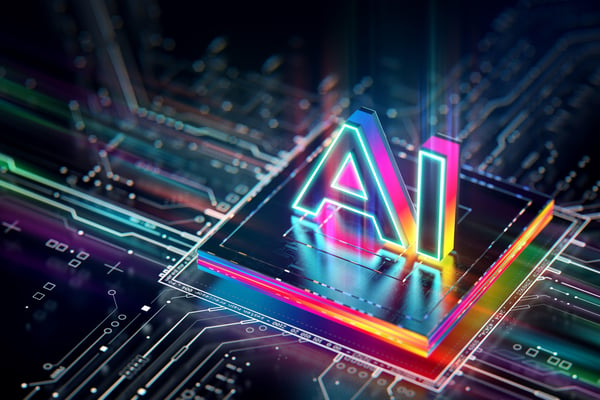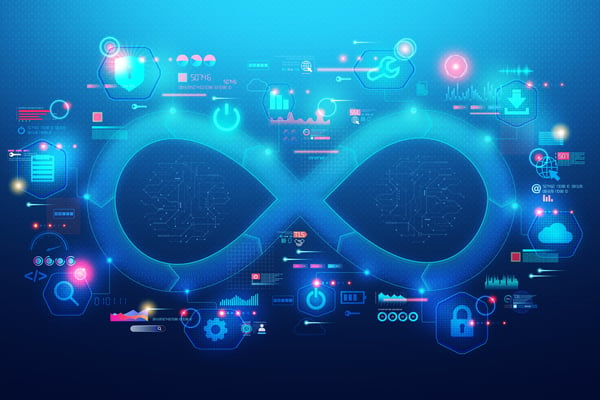In 2024, the world of technology continues to evolve at an unprecedented pace, revolutionizing industries and transforming the way we work. With the increased use of existing technologies and the development of new ones, the next year promises to be a game changer, introducing us to many cutting-edge innovations. In this blog post, we will explore 5 tech trends that are set to be prominent in 2024, propelling us into a future fueled by creativity and new digital transformation strategies.
1. AI takes center stage

The use of artificial intelligence (AI) is factored into many aspects of our business and personal lives. This is a new, and sometimes scary, phenomenon. Common concerns range from the fear that AI will cause widespread job loss to apocalyptic visions of robots taking over the world. One thing has become clear, AI isn’t a replacement for a human being who knows the company’s mission and brand values. It doesn’t check for things like inappropriate language or incorrect instructions.
Here are some of the ways AI will take on even more importance this year:
Responsible AI: ethics and governance in the age of automation

In 2024, companies will be concerned with AI’s business, legal and ethical implications and define governance strategies that mitigate risk. These efforts will focus on protecting user privacy, eliminating the potential for misuse of data and intellectual property, and maintaining data integrity and adherence to evolving laws and regulations.
If a company doesn’t implement AI technology properly, it can lead to missteps and poor decision-making based on inaccurate data. This can result in legal action, loss of trust and damage to its reputation. For example, generative AI tools are trained on data from multiple sources, including the internet, for both image and text generation. Data sources often remain anonymous, which can pose significant challenges for companies that deal with complex data or financial transactions. Unintentionally using an unknown data source, such as using another company’s intellectual property, can lead to costly legal penalties. So, businesses need to identify the source of this information to ensure compliance with legal, ethical and copyright issues.
Intelligent applications: revolutionizing daily work

Intelligent applications are software programs that use artificial intelligence (AI), machine learning and other advanced technologies to enhance their functionality, learn from data, make decisions and adapt over time. These applications can autonomously analyze data, understand patterns, predict outcomes and perform tasks that traditionally required human intervention.
For example, generative AI software takes the user experience of customers, users, product owners, architects and developers to a new level. In addition, intelligent applications provide far-reaching insights and deliver findings that business users can leverage for analytics and reporting. As a result, standalone business intelligence tools will become outdated. Through predictions or recommendations, AI also offers the opportunity to tailor applications more closely to their users and promote data-driven decision-making.
Cybersecurity: its applications and impact

Because of artificial intelligence (AI) and machine learning, many companies are already responding to cyberthreats in real-time. By continuously monitoring and analysis of network data, AI allows cybersecurity teams to proactively identify and prevent security threats such as unauthorized data transfer, illegal access, malicious credential use and theft of sensitive data. This enables companies to detect and resolve instances of suspicious activity before they become significant issues.
As AI continues to evolve, it’s become both a boon and a threat to cybersecurity. When used for cybercrime, these technological advances can enable more sophisticated and far-ranging attacks including highly convincing phishing emails, audio and video deepfakes and other hacking operations. Open-source AI tools that facilitate these types of breaches are already available online. Even inexperience cyber criminals will have the power to stage fully automated, AI-based attacks and experienced hackers will have the tools to create large-scale problems with more ease.
With this increased accessibility, the cybersecurity industry and corporate IT teams face significant new risks. Businesses need to prioritize training their IT staff in AI systems and implementing AI-based cybersecurity software to mount an aggressive defense. Since AI can spot potential threats, it enables IT teams to investigate them as they occur and react immediately.
It’s essential to understand both aspects of AI's potential, as well as to support government efforts to regulate its use before the issue gets to the point where controlling this use of AI becomes close to impossible to achieve.
2. What is datafication?

Datafication is a process in which technologies such as artificial intelligence, robotics and machine learning are used to transform various facets of business and everyday life into meaningful data. It involves the collection, analysis and use of data from multiple sources, including sensors, devices and online interactions.
Real-world phenomena such as human behavior and environmental conditions can also be transformed into quantifiable information. The insights gained from this data support decision-making drives innovation, increases efficiency and promotes personalized products and services.
The potential of datafication lies in predicting trends and customer behavior, optimizing work processes, influencing product development and strengthening data protection. Although datafication is already having a major impact, it will continue to grow in 2024 and beyond, with a focus on the collection, analysis and implementation of data across multiple sectors.
3. The augmented connected workforce: empowering employees 
The Augmented Connected Workforce (ACWF) is a strategic approach to maximizing the value of the employee performance and satisfaction, driven by the need to nurture and grow talent. Through intelligent applications and workforce analytics, ACWF provides contextualized guidance promoting employee well-being, experience and skills development, while delivering positive business outcomes and stakeholder impact.
ACWF, which integrates advanced technologies such as AI, augmented reality, virtual reality, the internet of things and networked systems, promotes improved productivity, streamlined operations and effective decision-making through the synergy of human expertise and technological capabilities. This 2024 trend reflects a collaborative, data-driven and adaptable working environment that facilitates success in today's dynamic market landscape.
4. Green cloud computing: the future of sustainable technology

Green cloud computing is the use of computers and other devices in an energy efficient and environmentally conscious way. The term can also be applied to the benefits gained directly from the migration of IT systems to the cloud. These efficiency improvements result from consolidating data centers, a concentration on supporting remote and hybrid workforces that reduce the environmental impact of commuting to the office and optimizing resource usage.
It requires the use of ethical and sustainable methods for sourcing and extracting materials needed to manufacture computer hardware and digital devices. It also involves responding to increasing infrastructure demands while seeking to reduce energy consumption and carbon emissions. Greener IT is often part of environmental and social governance programs (ESG). According to Deloitte, a global provider of consulting and financial services, “The goal of ESG is to capture all the non-financial risks and opportunities inherent in a company’s day to day activities.”
5. Quantum computing: unlocking the next frontier

Quantum computing is an interdisciplinary field that combines computer science, physics and mathematics, using the principles of quantum mechanics to tackle complex problems. Quantum computers can carry out an immense number of calculations simultaneously by leveraging components of quantum physics.
Traditional computers use bits which store data only as 1 (on) or 0 (off), while quantum bits (qubits) can exist in multiple states simultaneously using 1, 0 or both at once. This enables incredibly fast simultaneous and parallel calculations.
Early investors in quantum technology include banks and financial services that use it for fraud detection, risk management and other applications. It is expected to be applied to many computationally intensive fields, including drug discovery, genome sequencing, and complex activities such as controlling of traffic flow in large cities and simulating drug molecules and materials.
Conclusion
These are some of the most disruptive technology trends that will lead your digital journey in 2024. These technologies will also help meet your company's needs and requirements in unique ways and take your business to the next level. To stay ahead in this rapidly changing terrain, companies must not only be aware, but actively develop a deep understanding and skill set through continuous learning.
Joan Honig also contributed to this blog post



